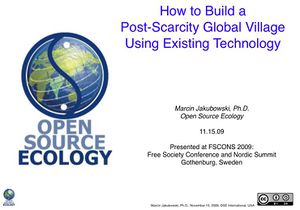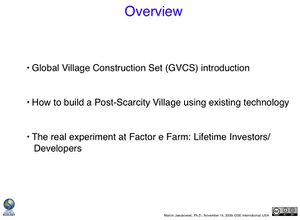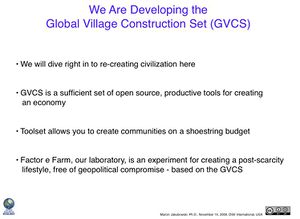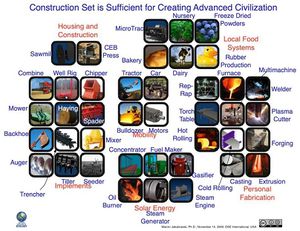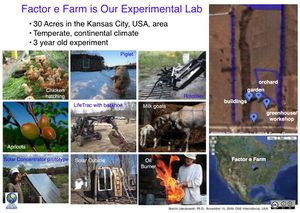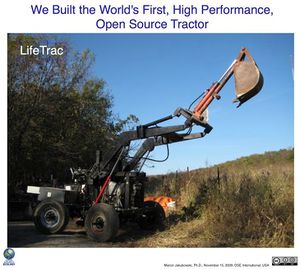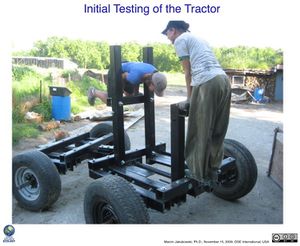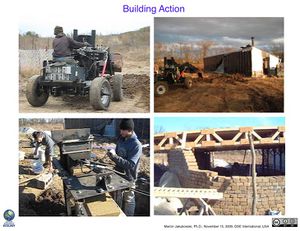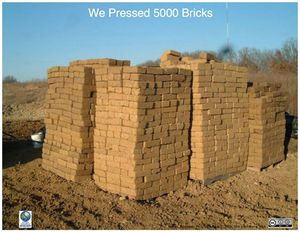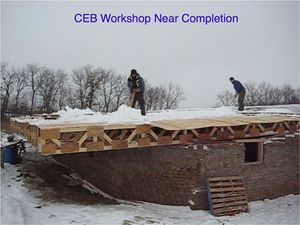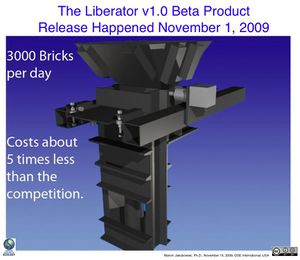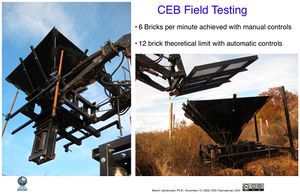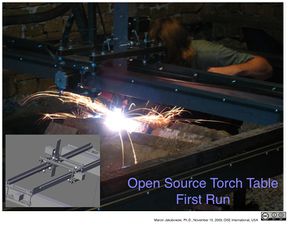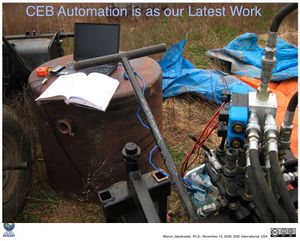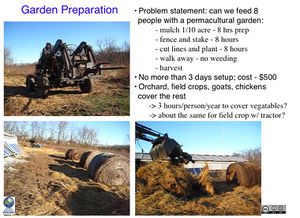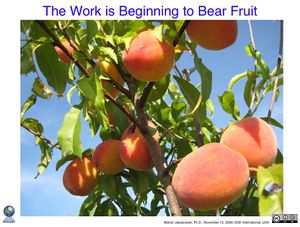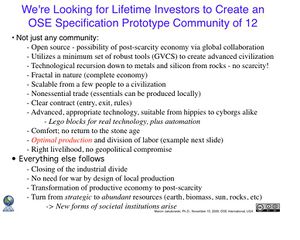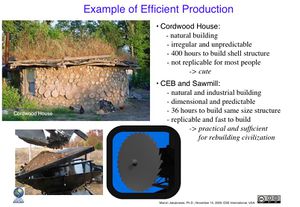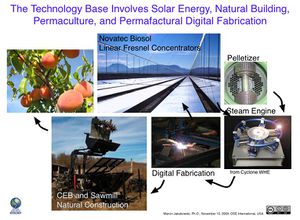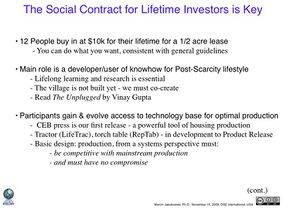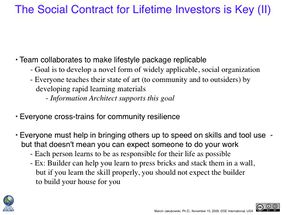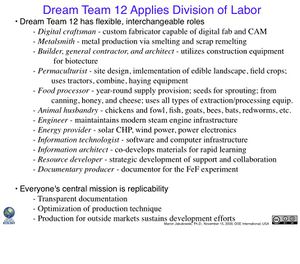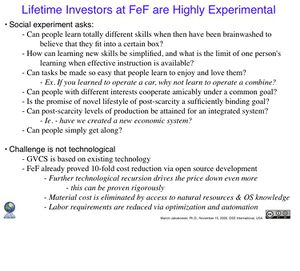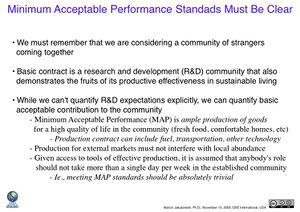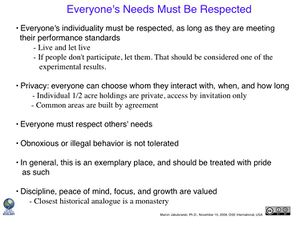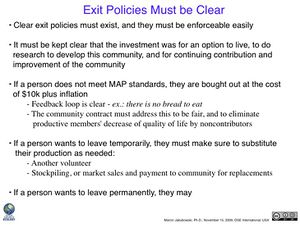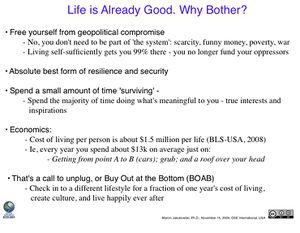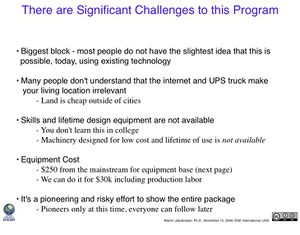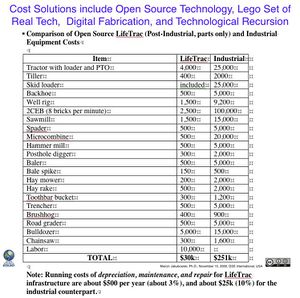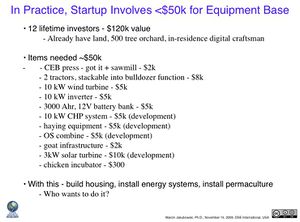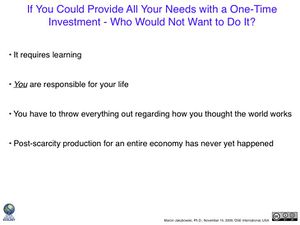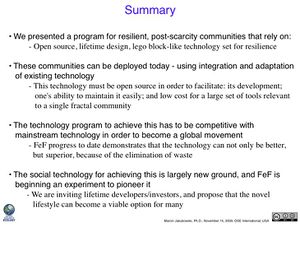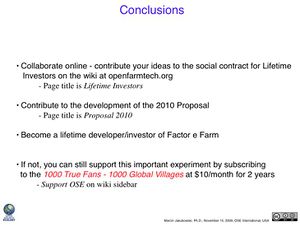FSCONS 2009 Slides
![]() It has been suggested that the text below be merged into (added to) the [[::Lifetime Investors|Lifetime Investors]] page. (Discuss)
It has been suggested that the text below be merged into (added to) the [[::Lifetime Investors|Lifetime Investors]] page. (Discuss)
Slide 1
The title of our presentation is How to Build a Post-Scarcity Village Using Existing Technology. My name is Marcin, originally from Poland, now based in the USA, Kansas City area. My background is a Ph.D. in physics in fusion energy, and I want a refund for my schooling, because I have since discovered that my schooling did not prepare me in any way for what was to come ahead.
We’ve got an interesting socio-technological experiment going on – on building the world’s first, replicable, post-scarcity, resilient community – or real people living on land, using their local resources. The key is open source collaboration to develop the place, and to reduce cost and skill barriers to make such a place replicable.
The title for this talk was originally Transformative Economics via Open Source Product Development – but that was rather abstract, and we have a very practical experiment on the ground. We are really building a post-scarcity village by means of open source development, so I’d like to focus on this as a clear, underlying theme. What we mean by this post scarcity village will become clear as the presentation progresses, and if it isn’t, we will have 45 minutes after this 45 minute talk for further discussion. Please note your questions and save them for the end, as the complexity of the subject makes that desirable, and the whole picture may emerge more clearly as the talk progresses.
Slide 2
The basic theme of a post-scarcity village is distributive production – production that tends to distribute benefit not to the few, but to as many as possible – consistent with concepts of Jeffersonian democracy. To this end, we are building an open source product development center as part of our post-scarcity village. We have defined a basic set of insfrastructure tools that can get us through survival, and onto a good footing for thriving – as the process of production becomes optimized, and therefore, trivial to accomplish. We are using existing technology – but opensourcing it – to build the foundation of a resilient community – and to deliver on the promise of technology to serve human needs – not humans serving the needs of technology. We have already obtained encouraging results on open product development, the most noteworthy of which is the product release of our first product – the high performance, open source, Compressed Earth Brick (CEB) press. With these initial results, we are beginning to talk seriously about design and build of a real community – one that delivers on unprecedented quality of life – but without geopolitical compromise. We are looking for lifetime codeveloper/investors to make this happen. We are to date funded entirely by crowd donations, and we publish all results openly.
Slide 3
is our experiment for creating a post-scarcity lifestyle, free of inherent participation in geopolitical compromise - killing, stealing, war, dumbing down of the population, etc.
Slide 4
Here is the hardware set. This set of hardware is minimal, and we propose that you can accomplish about 99% of the things you need to live and thrive with this set. It does not include turning rock into metal (advanced civilization) or turning rock into silicon (digital age) - but it does cover your food, shelter, energy, transportation, and most of your technology needs. We're talking about basics here, plus, with digital fabrication - or computer controlled fabrication fueled by a global repository of design (just coming into existence) - we can go down to creating other tools and components that complete the set to other areas including turning plants into fuels or turning rocks into metals and into silicon as mentioned.
Slide 5
Allow me to explain the technology set a little more, and how it applies to building a post-scarcity village from scratch. This 5-minute video begings to explain this process, and it represents the on-the-ground work, merely begun, going on at Factor e Farm (FeF).
How to Build a Post-Scarcity Village from Marcin Jakubowski on Vimeo.
Slide 6
Factor e Farm is our physical laboratory. It is a hackerspace of a different flavor - one where a community is being built from the earth and plants and around - by applying open source information to transform this earth and plants into the substance of surviving and thriving.
.
Slide 7
Some things we do are building open source tractors,though the feedstock is industrial metal.
.
Slide 8
Here we are doing initial testing on the tractor.
.
Slide 9
We build using the open source compressed earth block press which we designed and built. It's our first Product Release.
.
Slide 10
Here is a pile of 5000 bricks that we pressed last year.
.
Slide 11
We used them to build our workshop addition.
.
Slide 12
The high performance, open source CEB press is now in production - our first product release. You can buy one for $3500 if you are one of our True Fans, and $5500 if you are not. True Fans are supporters of our work - through the 1000 True Fans - 1000 Global Villages campaign, who agree to support us at $10/month for 2 years.
The press has produced 6 bricks per minute with manual controls, and now we're working on automation and optimization. We think we can get 12 bricks per minute with the automatic version.
Slide 13
You can look on our blog for more information on the initial field testing results, then the addition of the soil shaker, and [and announcement of product release.
.
Slide 14 - RepTab
We also did initial testing of the computer controlled torch table, which we are calling RepTab because it is self-replicating - which will be featured in Make Magazine in January.
The self-replicability comes from the fact that the entire gantry and motion structure, minus electronics and stepper motors, can be cut out on the table itself.
.
Slide 15
Our present work is CEB automation. We are using an Arduino microcontroller, connected to solenoid valves. We have gotten results corresponding up to 9 bricks per minute so far, but the existing valves cannot handle the power output of LifeTrac - so the next steps is larger valves.
.
Slide 16
We are also preparing garden beds for next year. It consists of 1/10 acre covered with about 7000 lb of straw mulch - or almost 4, large, round bales. The experiment is important - as we claim that with proper preparation - it should take about 6 hours per person per year, for an 8 person team - to grow the garden. Appropriate equipment helps. It's about technique and equipment if one wants to do this without effort.
The plan is quite simple and elegant - we'll report on the results after next year. We're 5 hours into that 48 hour experiment.
.
Slide 17
This 30 second video shows how more powerful equipment can assist human effort in the above task. We are using our soil pulverizer to pulverize bales.
Bale Munching with Soil Pulverizer from Marcin Jakubowski on Vimeo.
Slide 18
The permaculture work at FeF is beginning to bear fruit.
.
Slide 19
We move on to the social technology, which is the real challenge of such a community. We accept that there are limits to how far a single family unit can reach in terms of post-scarcity, integrated economic existence. So we learn from history, and organize villages.
We have an ambitious program in mind, and the community that we're interested in creating is not just any ordinary community. We are looking for people dedicated to create the world's first, replicable, post-scarcity village. There are several unique features.
- Open source - only by global collaboration and winnowing and sifting of what works and what doesn't can we come up with a robust technological and social design.
- We utilize a minimum set of tools - not too large - because then we could not manage/develop/opensource these tools as easily. So we limit ourselves to a wise, sufficient set of choices - but, choices that can still lead to advanced civilization.
- We master our technology base. That means we can produce the necessary technologies locally. This mean that with time, we will apply technological recursion - the substitution of our skill and labor for outside sourcing. This mean - we begin making components, and eventually begin to make the actual feedstocks that make these components. Everything comes from the earth - rocks give you metals and computers.
- We are interested in a complete economy. This means, the village is fractal by design - it is complete in itself, or it can scale to multiple units that form cities and regions. They are resilient because they utilize their local resources. To utilize local resources, technological mastery is a prerequisite.
- The participation contract for the village must be clear. It's a research and development community - entry, exit, policy. This is not just a bunch of hippies in the woods running around with knives and polyethylene.
- Advanced appropriate technology is key. We are not talking about going back to the stone age. We can have all the trappings of modernity, but we can do it ecologically. This could be attractive to back-to-the-landers and technophiles alike. We are building adaptable, Lego-block-like technology pieces, and automating production wherever desirable.
- A critical feature is optimal production. We must be able to provide needs efficiently - and this is the point that most hippy-in-the woods efforts are missing. This requires discipline and division of labor.
- There's a huge ethical point to this. There is no need for geopolitical compromise of killing and stealing from one another, leaving hordes of people deprived while a few at the top exist in a search for meaning.
From this design, everything follows. We close the industrial divide between the North and South - as technological advancement can be shared readily via the internet. There is no need for war because production is local. Strategic resources exist no more - as appropriate technology is able to generate needed services from abundant resources of earth, biomass, sun, rocks, etc. We are talking of no less than post-scarcity, new forms of societal organization, and all the tools necessary to get there are now in existence in the digital age.
Slide 20
One important point is efficient production. Allow me to demonstrate. We built this cordwood building with 400 human hours of labor for a shell structure without furnishing. This was arduous, irregular, unpredictable. This is not efficient from the replicability standpoint. It is cute.
That's why the CEB Press and Sawmill are parts of the GVCS. See CEB Story for more details. The point is, the CEB and sawmill are efficient, natural, dimensional, and industrial. They are easy to build with, so you need about 10 times less time to build a similar structure. This is practical and sufficient for rebuilding civilization, if that is our goal. The CEB we have, we will be building the sawmill in February.
Slide 21
The technology plan includes the standard cast of characters: building infrastructure, solar enregy, permaculture, digital fabrication, fuels and steam power.I won't get into the details, except make a few points. Solar linear fresnel design - seen in the picture, as done by Novatec Biosol, is proven - and we want to scale it down to home and village size of about 3kW and up. We believe we can do that if we have access to an open source, modern steam engine - and we propose the Steam Engine Construction Set. Combined with tractor -> hay bales -> pelletizer - we can fuel the steam engine with biomass pellets or the sun - for a combined heat and power (CHP) system. We can then power digital fabrication, to build more tractors and solar power systems, and the tractors can help us grow food. It's not that complicated.
Slide 22
The social technology is more complicated, because we need to get a number of diverse people to get along.
The basic program is that you buy in, now we're considering $10k a pop - for a 1/2 acre lifetime lease at FeF. You are free to do what you want with your share.
The contract is that you agree to participate actively in developing and improving the design and infrastructure of a replicable, post-scarcity community. This means a lifestyle of research and lifelong learning, where you must recognize that the village is not built yet. Think of it as a clear slate. And read The Unplugged by Vinay Gupta to see a fictional account quite similar to what we're proposing.
The role of the participants is to not only fund necessary developments through their acceptance fee, but to do development work - to create an infrastructure competitive with and superior to mainstream infrastructures. We do this simply by repackaging existing knowhow in the open framework of open source design. We can do this without compromising any human values, by taming technology towards true human service.
Slide 23
The team collaborates to make the entire package of lifestyle replicable - to those following these footsteps. While the development team must have pioneering skills, many can follow once the package is created.
